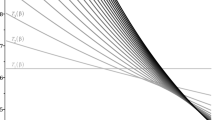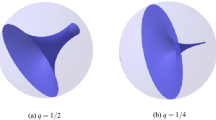Abstract
We show that the singularities of the Fresnel surface for Maxwell’s equation on an anisotrpic material can be accounted from purely topological considerations. The importance of these singularities is that they explain the phenomenon of conical refraction predicted by Hamilton. We show how to desingularise the Fresnel surface, which will allow us to use Morse theory to find lower bounds for the number of critical wave velocities inside the material under consideration. Finally, we propose a program to generalise the results obtained to the general case of hyperbolic differential operators on differentiable bundles.
Similar content being viewed by others
References
M. Born and E. Wolf, Principles of Optics. Electromagnetic Theory of Propagation, Interference, and Diffraction of Light (Pergamon Press, New York, 1959).
J. W. Milnor, Morse Theory, in Ann. of Math. Stud. (Princeton Univ. Press, Princeton, NJ, 1963), Vol. 51.
C. Valero, “Morse theory for the eigenvalue functions of symmetric tensors,” J. Topol. Anal. 1 (4), 417–429 (2009).
V. Guillemin and S. Sternberg, Geometric Asymptotics, in Math. Surveys Monogr. (Amer. Math. Soc., Providence, RI, 1977), Vol. 14.
L. Hörmander, “Hyperbolic systems with double characteristics,” Comm. Pure Appl. Math. 46 (2), 261–301 (1993).
F. John, “Algebraic conditions for hyperbolicity of systems of partial differential operators,” Comm. Pure Appl. Math. 31, 89–106 (1978).
B. A. Khesin, “Singularities of light hypersurfaces and structure of hyperbolicity sets for systems of partial differential equations,” in Theory of Singularities and Its Applications, Adv. Soviet Math. (Amer. Math. Soc., Providence, RI, 1990), Vol. 1, pp. 105–118.
P. D. Lax, “The multiplicity of eigenvalues,” Bull. Amer. Math. Soc. 6, 213–214 (1982).
W. Nuij, “A note on hyperbolic polynomials,” Math. Scand. 23, 69–72 (1968).
P. J. Braam and J. J. Duistermaat, “Normal forms of real symmetric systems with multiplicity,” Indag. Math. (N. S.) 4 (4), 407–421 (1993).
V. I. Arnold, Singularities of Caustics and Wave Fronts, in Math. Appl. (Soviet Ser.) (Kluwer Acad. Publ., Dordrecht, 1990), Vol. 62.
Author information
Authors and Affiliations
Corresponding author
Additional information
Original Russian Text © C. Valero, 2016, published in Matematicheskie Zametki, 2016, Vol. 100, No. 3, pp. 331–343.
Rights and permissions
About this article
Cite this article
Valero, C. Maxwell’s equations, the Euler index, and Morse theory. Math Notes 100, 352–362 (2016). https://doi.org/10.1134/S0001434616090029
Received:
Published:
Issue Date:
DOI: https://doi.org/10.1134/S0001434616090029




